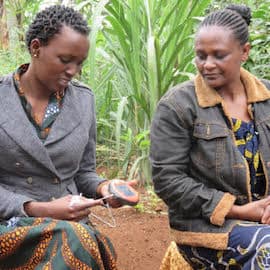Geodata Technology Moving Into New Fields. Literally.
Geodata and ICT applications help farmers around the world with precision farming. They receive weather information and advice on which seeds or fertilizers to use and when to irrigate their plots. That leads to increased yields and improved quality. This information has not yet been made available to financial institutions at a large scale but it has an enormous potential to increase access to finance for smallholder farmers.
That’s why NpM Platform for Inclusive Finance, Rabobank Foundation and the Netherlands Space Office (NSO) organised the conference “Geodata for Inclusive Finance and Food” earlier this year. (See a related video below.) The aim of the event was to inspire, share knowledge and link the three worlds of technology, food and finance. The publication “Geodata and ICT Solutions for Inclusive Finance and Food Security” was released at the conference. It includes an investigation of more than 250 cases of technology applications in rural finance, including NSO’s Geodata for Agriculture and Water (G4AW) facility, which is funded by the Dutch Ministry of Foreign Affairs.
The research was carried out by ICCO Terrafina Microfinance and revealed there is fast growth in geodata and ICT applications and services that:
- Improve agricultural production by using data that focus on improving farmers’ use of inputs, planting dates and crop calendar, soil conditions and so on.
- Provide market information to farmers and businesses in agro-value chains and improve planning at the macro level.
- Improve financial inclusion in rural areas through provision of investment loans and working capital, digital payments systems and microinsurance. These developments positively affect both the cost-effectiveness and growth in outreach of financial services.
Perspective of the user
Users of these services can be smallholder farmers, financial service providers (FSPs), governments and development organizations. They have different profiles and needs.
For smallholder farmers who are dependent on the weather and crop cycles, getting the right information on time is critical. Extreme weather events caused by climate change are becoming more frequent and increase the demand for advice on climate-smart agriculture. Because many smallholder farmers lack a formal education, it is important that the information is easy to understand and available in local languages. Finally, farmers may have follow-up questions after receiving the advice, requiring applications to be interactive as well.
For financial service providers, geodata and ICT solutions can also be of great value. By improving smallholder farmers’ productivity and access to markets, farmers’ risk profiles can be lowered. This provides a stimulus for financial institutions to provide more and better financial services to them, thereby increasing outreach. Secondly, geodata and ICT solutions have the potential to substantially reduce transaction and monitoring costs for FSPs. Instead of visiting clients in the field to monitor their farm productivity, a loan officer can now use technology to do so from a distance.
Finally, governments and development organizations can greatly benefit from more accurate and timely information. For instance, ministries of agriculture can better target their interventions in the agricultural sector and NGOs can improve their extension services to smallholder farmers.
Linking geodata and ICTs to financial services
Information based on satellite data and ICT applications is becoming increasingly available for smallholder farmers. There are indeed some cases of microinsurance providers that use geodata and ICT solutions for their service. However, the research found that there are not yet many examples of financial service providers linking geodata and ICTs with their provision of working capital or investment loans. Below are two success stories of organizations that do establish this link.
The CommonSense (download) project in Ethiopia, which is part of the G4AW (Geodata for Agriculture and Water) facility, provides smallholder farmers with information based on earth observation and geographic data. Services include localized weather data, crop monitoring and yield forecasting, crop suitability advice and market price information. All of this improves their production and access to markets. At the same time, the microfinance institutions (MFIs) that are supported by ICCO Terrafina Microfinance are assisted to improve their risk assessment and loan monitoring by using applications based on geodata. This lowers monitoring and transaction costs on the one hand, and increases their outreach on the other hand.
Another example is the financing of cocoa farmers by Opportunity Bank Ghana. Loan officers are equipped with a GPS handheld device that determines the location and exact land area available for farming, the position of the farmer’s house, altitude and access to water/irrigation. This is combined with information on a farmer’s household profile and fed into a customer relationship management (CRM) tool to determine whether a farmer is able to run a business and get a loan. With the help of the mapping tool, loan clients receive inputs based upon the actual acreage of their farm plots to maximize production and household income. Farmers’ spending on inputs is reduced significantly, thereby improving their repayment capacity. For Opportunity Bank Ghana, yields can be more accurately estimated and a more tailored package of financial services can be offered. Ultimately this reduces the risks and costs associated with agricultural lending and expands Opportunity’s client base.
The way forward
The potential of using technology in agriculture and financial inclusion is huge and several lessons can already be drawn from the study to improve and scale up the services:
- A good policy and regulatory environment is required that stimulates innovation while safeguarding privacy rights, transparency and stability in the business environment and financial system.
- Design services for smallholder farmers and other users that are tailored to their needs. Information can be based on the same data source, but has to be relevant to the user; a farmer might be better served by receiving a text message with localized weather information warning him/her about an upcoming drought, whereas a financial institution might be more interested in weather information on an aggregated level. This also requires financial institutions’ IT systems to be able to process and analyze agricultural data and geodata.
- Financial institutions, especially those operational in rural areas, need guidance and support. Staff capacity, financial constraints and digital illiteracy are bottlenecks that need to be overcome.
- New technology requires high upfront development costs. While the private sector is getting involved, the current business case for serving smallholder farmers is not yet evident. Donors, governments and (social) investors can play an active and important role in providing high-risk bearing capital for scaling up and assisting services to become commercially viable.
- Special attention is needed to include youth and women so they too can benefit from the new technologies.
Geodata and ICT solutions thus offer promising opportunities for improving food security and access to finance. The Rabobank Foundation and NpM have therefore launched a Board of Inspiration aimed at promoting the use of satellite data for financing smallholder farmers in developing countries. Participating organisations in the board are Rabobank Foundation, the Dutch Development Bank FMO, the Dutch Ministry of Foreign Affairs and the Bill & Melinda Gates Foundation.
Josien Sluijs is director of NpM, Platform for Inclusive Finance.
Photo of Andre Kuipers, a Dutch astronaut, at the “Geodata for Inclusive Finance and Food” conference. Courtesy of NpM, Platform for Inclusive Finance
Homepage photo: CIAT, via Flickr.
- Categories
- Agriculture, Technology



